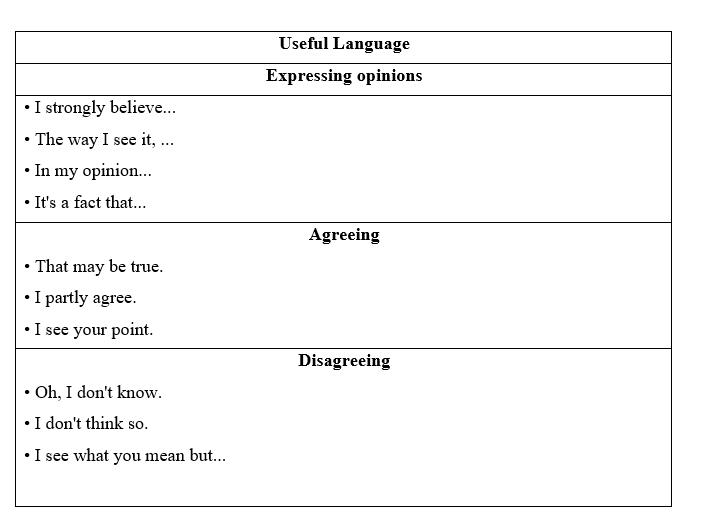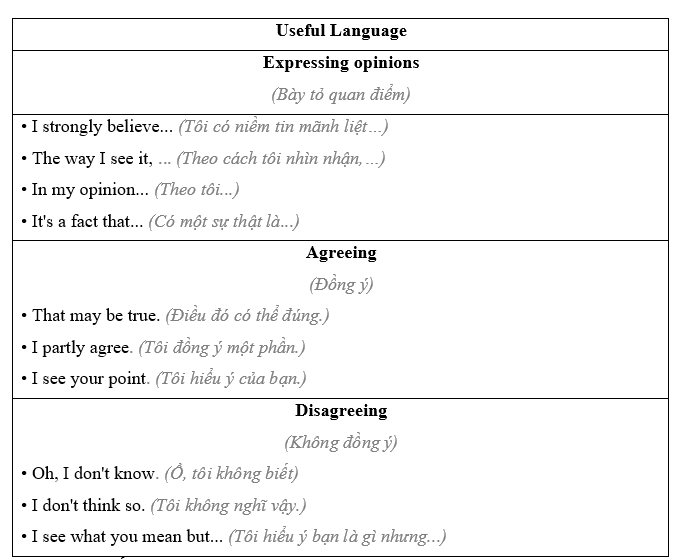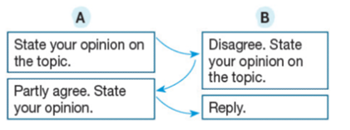Tiếng Anh 11 Bright Unit 6 6d. Speaking
1 a) Fill in each gap with cash, equal shelters, stamps or training. Then listen and check. b) Can you think of other ways to help citizens in need? 2 a) Listen and read the dialogue. What are Jeff and Nancy discussing? b) Which of the underlined phrases/ sentences are used for expressing opinions? agreeing? disagreeing? 3. Replace the underlined phrases / sentences in the dialogue in Exercise 2 with ones from the Useful Language Box.
Bài 1 a
Public service help
1 a) Fill in each gap with cash, equal shelters, stamps or training. Then listen and check.
(Điền vào mỗi khoảng trống bằng cash, equal shelters, stamps hoặc training. Sau đó nghe và kiểm tra.)
PUBLIC SERVICES
provided by governments can help citizens by...
• offering skills, 1) _________ and work opportunities to unemployed people
• providing free healthcare and hospital services
• offering free education and books to all students
• building 2) _________ for homeless people and providing free meals
• giving poor families 3) _________ donations
• giving food 4) _________ to poor people
• passing laws to ensure 5) _________ opportunities between men and women of all nations
Phương pháp giải:
*Nghĩa của từ vựng
cash (n): tiền mặt
equal (adj): công bằng
shelters (n): nơi trú ẩn
stamps (n): tem phiếu
training (n): đào tạo
Lời giải chi tiết:

PUBLIC SERVICES
provided by governments can help citizens by...
• offering skills, 1) training and work opportunities to unemployed people
• providing free healthcare and hospital services
• offering free education and books to all students
• building 2) shelters for homeless people and providing free meals
• giving poor families 3) cash donations
• giving food 4) stamps to poor people
• passing laws to ensure 5) equal opportunities between men and women of all nations
Tạm dịch
CÁC DỊCH VỤ CÔNG CỘNG
được cung cấp bởi các chính phủ có thể giúp công dân bằng cách ...
• cung cấp các kỹ năng, cơ hội đào tạo và làm việc cho những người thất nghiệp
• cung cấp dịch vụ chăm sóc sức khỏe và bệnh viện miễn phí
• cung cấp giáo dục và sách miễn phí cho tất cả học sinh
• xây dựng 2) nơi tạm trú cho người vô gia cư và cung cấp bữa ăn miễn phí
• tặng hộ nghèo 3) tiền mặt quyên góp
• phát 4) tem phiếu thực phẩm cho người nghèo
• thông qua luật để đảm bảo 5) cơ hội bình đẳng giữa nam và nữ ở tất cả các quốc gia
Bài 1 b
b) Can you think of other ways to help citizens in need?
(Bạn có thể nghĩ ra những cách khác để giúp đỡ những công dân gặp khó khăn không?)
Lời giải chi tiết:
- Providing affordable housing: Governments can work to create and maintain affordable housing options for citizens who are struggling to make ends meet.
(Cung cấp nhà ở giá rẻ: Chính phủ có thể làm việc để tạo ra và duy trì các lựa chọn nhà ở giá rẻ cho những công dân đang phải vật lộn để kiếm sống.)
- Offering childcare support: Providing affordable or subsidized childcare options can help support working parents and reduce the financial burden of childcare.
(Hỗ trợ chăm sóc trẻ: Cung cấp các lựa chọn chăm sóc trẻ với giá phải chăng hoặc được trợ cấp có thể giúp hỗ trợ các bậc cha mẹ đang đi làm và giảm gánh nặng tài chính cho việc chăm sóc trẻ.)
- Creating job training programs: Offering training programs for in-demand jobs and industries can help individuals gain the skills they need to secure stable employment.
(Xây dựng các chương trình đào tạo nghề: Cung cấp các chương trình đào tạo cho các ngành và công việc đang có nhu cầu có thể giúp các cá nhân đạt được các kỹ năng cần thiết để đảm bảo việc làm ổn định.)
Bài 2 a
Everyday English
Expressing opinions & Agreeing / Disagreeing
2 a) Listen and read the dialogue. What are Jeff and Nancy discussing?
(Nghe và đọc đoạn đối thoại. Jeff và Nancy đang thảo luận điều gì?)
Jeff: Nancy, I am writing an essay about education. 1) To my mind, education should be free, so everyone has a chance to study.
Nancy: 2) I'm not sure. That would cost the government a lot of money. 3) It seems to me that education should be free only for those who cannot afford it.
Jeff: 4) You've got a point there. 5) Personally, I think it is the government's responsibility to provide education to all.
Nancy: Well, let's agree to disagree!
Phương pháp giải:
Tạm dịch
Jeff: Nancy, tôi đang viết một bài luận về giáo dục. 1) Theo tôi, giáo dục phải miễn phí để mọi người đều có cơ hội học tập.
Nancy: 2) Tôi không chắc. Điều đó sẽ tiêu tốn của chính phủ rất nhiều tiền. 3) Đối với tôi, có vẻ như giáo dục chỉ nên miễn phí cho những người không đủ khả năng chi trả.
Jeff: 4) Đó là một ý hay. 5) Cá nhân tôi nghĩ chính phủ có trách nhiệm cung cấp giáo dục cho tất cả mọi người.
Nancy: Chà, thôi gác chuyện này sang một bên!
Lời giải chi tiết:
Jeff and Nancy are discussing the idea of free education. Jeff believes that education should be free for everyone, while Nancy is skeptical and suggests that education should only be free for those who cannot afford it.
(Jeff và Nancy đang thảo luận về ý tưởng giáo dục miễn phí. Jeff tin rằng giáo dục nên miễn phí cho tất cả mọi người, trong khi Nancy tỏ ra nghi ngờ và gợi ý rằng giáo dục chỉ nên miễn phí cho những người không đủ khả năng chi trả.)
Bài 2 b
b) Which of the underlined phrases/ sentences are used for expressing opinions? agreeing? disagreeing?
(Những cụm từ / câu được gạch dưới được sử dụng để bày tỏ ý kiến? đồng ý? không đồng ý?)
Lời giải chi tiết:
Opinions:
(Ý kiến)
- To my mind
(Theo tôi)
- It seems to me that
(Theo tôi thì)
- Personally, I think
(Cá nhân tôi nghĩ")
Agree
(Đồng ý)
- You've got a point there
(Đó là một ý hay)
Disagree
(Không đồng ý)
- I'm not sure
(Tôi không chắc)
Bài 3
3. Replace the underlined phrases / sentences in the dialogue in Exercise 2 with ones from the Useful Language Box.
(Thay thế các cụm từ / câu được gạch chân trong đoạn hội thoại ở Bài tập 2 bằng các cụm từ / câu có ích trong Hộp ngôn ngữ hữu ích.)
Tạm dịch

Lời giải chi tiết:
1) To my mind => In my opinion...
(Theo suy nghĩ của tôi => Theo ý kiến của tôi...)
2) I'm not sure => Oh, I don't know.
(Tôi không chắc => Ồ, tôi không biết.)
3) It seems to me that => The way I see it, ...
(Dường như với tôi => Theo cách tôi nhìn nhận, ...)
4) You've got a point there => I see your point.
(Đó là một ý hay => Tôi hiểu quan điểm của bạn.)
5) Personally, I think => I strongly believe...
(Cá nhân tôi nghĩ => Tôi tin tưởng mạnh mẽ...)
Bài 4
4. You are discussing the topic: Should we help the homeless? Act out a dialogue similar to the one in Exercise 2. Use the diagram below. Mind the intonation and rhythm.
(Các bạn đang thảo luận về chủ đề: Có nên giúp đỡ người vô gia cư? Làm một đoạn đối thoại tương tự như đoạn trong Bài tập 2. Sử dụng sơ đồ bên dưới. Nhớ ngữ điệu và nhịp điệu.)

Lời giải chi tiết:
A: Hi, I was thinking about the homeless situation in our city. I believe we should help them in some way.
B: Well, it's a tough issue. How do you propose we help them?
A: I think we could start by offering shelters and food donations.
B: Hmm, I'm not sure that's a long-term solution. What about job training programs or mental health services to help them get back on their feet?
A: That's a good point. But we could also start by donating money or supplies to homeless shelters.
B: Yes, donating is always helpful. But ultimately, we need to address the root causes of homelessness and work to create more affordable housing options.
A: I see your point. It's a complex issue that requires a multifaceted approach.
B: Exactly. We need to work together and address the issue from multiple angles.
Tạm dịch
A: Xin chào, tôi đang nghĩ về tình trạng vô gia cư ở thành phố của chúng ta. Tôi tin rằng chúng ta nên giúp đỡ họ theo một cách nào đó.
B: Chà, đó là một vấn đề khó khăn. Làm thế nào để bạn đề xuất chúng tôi giúp họ?
A: Tôi nghĩ chúng ta có thể bắt đầu bằng cách cung cấp nơi trú ẩn và quyên góp thực phẩm.
B: Hmm, tôi không chắc đó là giải pháp lâu dài. Thế còn các chương trình đào tạo nghề hoặc dịch vụ sức khỏe tinh thần để giúp họ đứng vững trở lại thì sao?
A: Đó là một ý tốt. Nhưng chúng ta cũng có thể bắt đầu bằng cách quyên góp tiền hoặc vật dụng cho những nơi trú ẩn dành cho người vô gia cư.
B: Vâng, quyên góp luôn hữu ích. Nhưng cuối cùng, chúng ta cần giải quyết các nguyên nhân gốc rễ của tình trạng vô gia cư và nỗ lực tạo ra nhiều lựa chọn nhà ở hợp túi tiền hơn.
A: Tôi hiểu ý của bạn. Đó là một vấn đề phức tạp đòi hỏi một cách tiếp cận nhiều mặt.
B: Chính xác. Chúng ta cần làm việc cùng nhau và giải quyết vấn đề từ nhiều góc độ.
Bài 5
Pronunciation Elision of /ǝ/
(Cách phát âm của /ǝ/)
In spoken English, the sound /ǝ/ is often left out when it occurs before /1/, /r/ or /n/ in some words. before elision after elision
(Trong tiếng Anh nói, âm /ǝ/ thường bị bỏ đi khi đứng trước /1/, /r/ hoặc /n/ trong một số từ. trước khi lược bỏ và sau khi lược bỏ.)

5. Listen and mark the /ǝ/ sounds that are not pronounced. Listen again and repeat. Practise saying them.
(Nghe và đánh dấu những âm /ǝ/ không được phát âm. Nghe lại và lặp lại. Thực hành nói chúng.)

Lời giải chi tiết:
1 different /ˈdɪf.ər.ənt/
2 burglary /ˈbɜː.ɡlər.i/
3 hospital /ˈhɒs.pɪ.təl/
4 donation /dəʊˈneɪ.ʃən/
5 assistant /əˈsɪs.tənt/
6 family /ˈfæm.əl.i/
7 racism /ˈreɪ.sɪ.zəm/
8 disabled /dɪˈseɪ.bəld/












